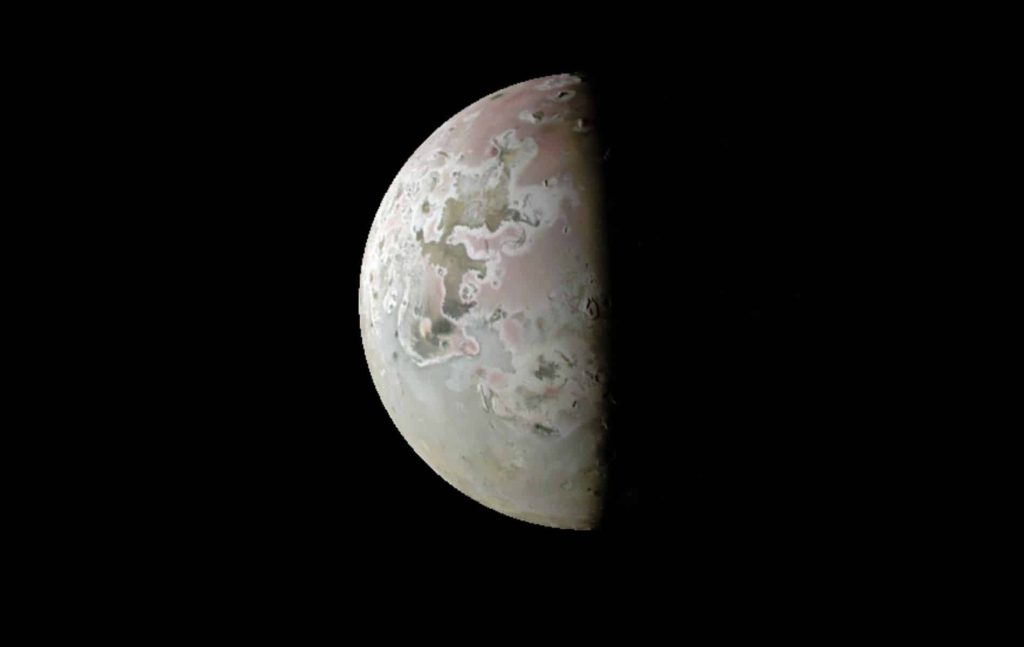Something special will happen Saturday on the planet Io, one of Jupiter's four large moons. Then, for the first time in twenty years, a spacecraft gets very close. This will definitely result in amazing shots.
One day before New Year's Eve, NASA's Juno space probe will arrive within about 1,500 kilometers of the surface of Io, the largest volcanic realm in our solar system. It should provide a mountain of useful data for researchers on the ground.
“By combining data from this flight with previous observations, scientists can study how different Io's volcanoes are,” said Scott Bolton, Juno's principal investigator from Texas. “We want to know how often it erupts, how much light it emits, how hot it is, but also how the shape of the lava flow changes and how Io's activity relates to the flow of charged particles in Jupiter's magnetosphere.”
Magma ocean
This is not the only time that Juno, which flies on solar power, will approach the private moon at a close distance, as the space probe will pass again on February 3 of next year. Juno has previously approached the moon at distances ranging between 11,000 and 100,000 km. It provided the first images of the north and south poles of the moon, which is also called the “pizza moon” because of its surface. Juno also visited Jupiter's icy moons Ganymede and Europa.

But now the space probe is one step closer and astronomers hope to find the answer to another important question, which is what is the source of Io's massive volcanic activity: for example, is there a magma ocean hiding beneath the moon's surface, and how? What is the importance of Jupiter's tidal forces? , which puts enormous pressure on IU? The space probe, which is already in its third year on Jupiter, will study the rings in which some of the moons are located.
Three cameras
Juno has three cameras on board, all doing their best to capture everything as best as possible during the flight flew by. the Jovian auroral infrared chart JIRAM takes infrared images to measure the heat emanating from volcanoes and craters. the Stellar reference unit Delivers the highest resolution surface images to date. Then there's the JunoCam, which takes color images of visible light. It was added once for the general public, but was actually only intended for eight flybys of Jupiter. However, Io's next flyby will be Juno's 57th orbit around Jupiter. This means that the space probe and its cameras have withstood almost as long as the most intense radiation in our entire solar system.
“We're starting to feel the effects of all this radiation at JunoCam,” said Ed Hirst, NASA's Juno project manager. “The images from the last flight are of slightly lower quality. Our technical team is working on solutions to reduce radiation damage and keep the camera working.
Another extension
Because NASA researchers can't get enough of it. After the mission has already been extended once, seven additional flybys will pass by Io. In all, Juno will fly by the volcanic moon eighteen times. The revolutions around Jupiter are going faster and faster. Io's gravity during the Dec. 30 visit will increase the spacecraft's orbit from 38 to 35 days, and after the Feb. 3 flyby, it will take just 33 days to orbit the gas giant.
The new path causes Jupiter to block the Sun from the spacecraft for five minutes, when the probe is closest to the planet. Although this is the first time the solar-powered spacecraft has flown in the dark since it passed Earth in October 2013, the darkness is too brief to affect the spacecraft. And that's a good thing, because until the end of the journey (the end of 2025), Juno will experience a solar eclipse like this every time it comes close to Jupiter.
Mon io pizza
Io has more than four hundred volcanoes. No celestial body in our solar system experiences this amount of volcanic activity. Volcanoes spew sulfur dioxide, creating their own atmosphere around Io. Much of the sulfur dioxide also ends up in space. The volcanic activity is caused by Jupiter's enormous gravity, which generates friction and heat in Io. The large moons Ganymede and Europa also heat Io's interior, causing volcanoes to form on the surface.

“Coffee buff. Twitter fanatic. Tv practitioner. Social media advocate. Pop culture ninja.”











More Stories
Which can cause an increase in nitrogen.
The Central State Real Estate Agency has no additional space to accommodate Ukrainians.
The oystercatcher, the “unlucky national bird,” is increasingly breeding on rooftops.